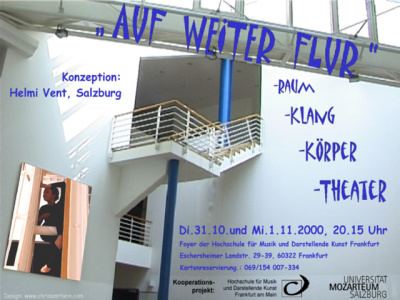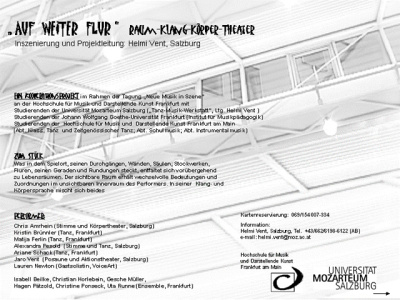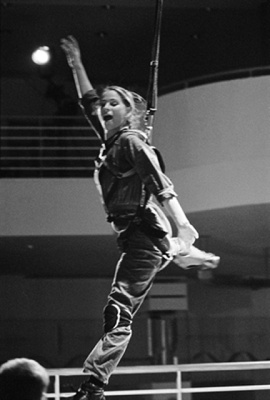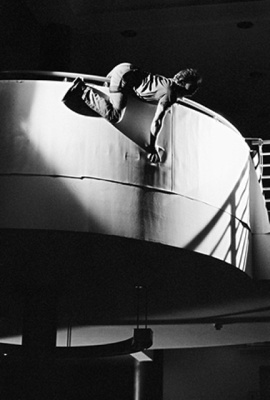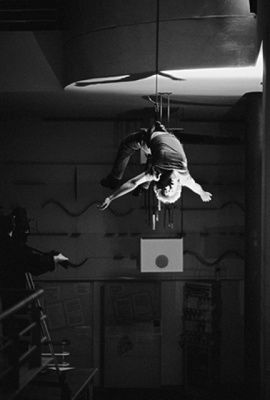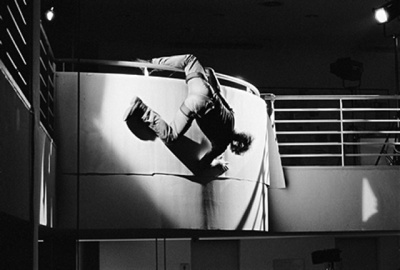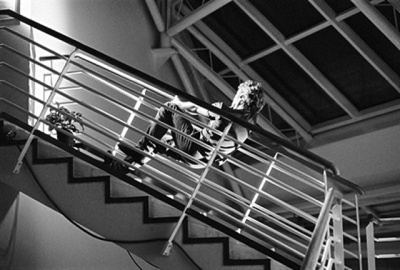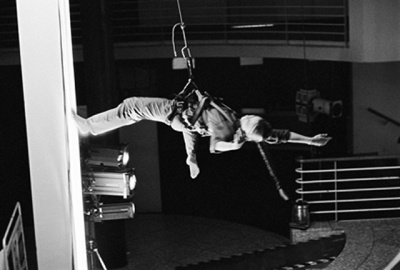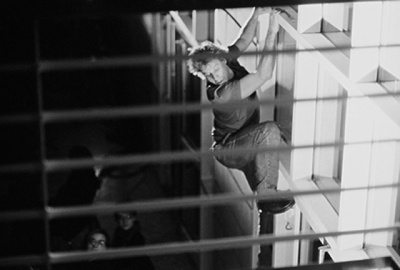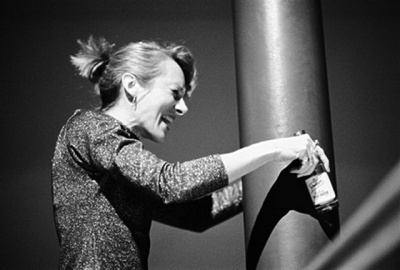2000 In Endless Halls
Kristin Brünnler, Lauren Newton, Chris Amrhein, Alexandra Pesold, Hagen Pätzold, Jaro Vent
Project Direction, Concept and Staging
Helmi Vent
Project Partners
DanceMusicTheaterLaboratory, University Mozarteum Salzburg (Austria)
Dept. of Classical and Contemporary Dance, Dept. of School Music, Dept. of Instrumental Music of the Hochschule für Musik und Darstellende Kunst, Frankfurt (Germany)
Institute for Music Pedagogy of the Johann-Wolfgang-Goethe-Universität (Johann Wolfgang Goethe University) Frankfurt (Germany)
Performers
Chris Amrhein (voice, action theater)
Kristin Brünnler (dance)
Matija Ferlin (dance)
Lauren Newton (as a guest – voice art)
Hagen Pätzold (trumpet)
Alexandra Pesold (voice, dance)
Ariane Schack (dance)
Jaro Vent (trombone, action theater)
Christine Ponseck (Stimme)
and others
Lighting Equipment and Lighting Design
Thomas Märker
Project Location
Foyer of the Hochschule für Musik und Darstellende Kunst, Frankfurt (Germany)
Performances
31 October 2000
01 November 2000, 18:00 and 20:00
SpaceSoundBodyTheater for the opening of the conference "Neue Musik in Szene" (New Music on the Scene)
Frankfurt, Oct./Nov. 2000
A cooperation project between Universities in Salzburg (Austria) and Frankfurt (Germany)
About the Project
........ an open work, corresponding to the open space of the entrance hall extending over three stories of the Hochschule für Musik und darstellende Kunst in Frankfurt, in which the entrances and exits, with their stairs, halls, banisters and projections, become platforms or even inclined planes on which people, with their various sound and body languages, become involved in conversation, sometimes deliberately, sometimes more or less incidentally in passing. The act of passing through developed into a defining element of the whole 'Halls' piece, since not a single rehearsal took place without 'crossing pedestrians' ('Quergänger') – who move across the rehearsal space in large or small groups, with or without instrument cases, sometimes munching on snacks or carrying music stands. These people became an actual part of the 'Halls' set: talking loudly, cautiously waiting, watching with fascination or aggravatedly complaining. In the course of the one-semester development work, these 'crossing pedestrians' wrote its own dynamic story, including their acoustic 'cross-relations' ('Querstände') – intermittent five or ten-second openings and closings of some practice room door or other that briefly flooded our rehearsal with a wave of different world music in a crescendo and diminuendo that seemed almost composed.
The fact that such audible and visible crossing pedestrians repeatedly pass through the staged version of the 'Halls' piece is nothing other than a homage to everyday life in the Frankfurt Hochschule entrance hall, which, seemingly of its own volition, spotlights itself in the 'Halls' scene through its 'marginal notes' – including two dancers (Ariane Schack and Matija Ferlin) who, in the mezzanine part of the entrance hall, let their bodies droop in relaxation during a well-earned break after an exhausting dance rehearsal, as they do several times every day. Particularly this dance-break duo – and we are thankful to daily life in the entrance hall for this – repeatedly directs our attention to the old theater question, namely, where theater – and in the latter case, 'theater in theater' begins and where it ends. Of course, we know that this is a matter of subjective perception, and yet: seldom have we felt its impact so red-hot, as it were, probably because often our long-debated 'positions' – as if by conspiracy – were seriously obstructed, which was very unsettling.
What holds the piece together is the winding, danced 'endless ribbon' under the 18-meter-long bench on the mezzanine level, curved in shape like a grand piano. Within the narrow space between bench and floor, the figure of the dancer (Kristin Brünnler) makes herself at home, engaging in ever new variations of winding, turning, and feeling her way. The 38 centimeters between the bench and the floor are never too low for her, nor are the possibilities for stretching too limited. Inwardly, this figure has long since accepted her spatial restrictions and has created her own expansiveness and certain forms of unusual free spaces in her strictly enclosed landscape. Each visitor meets the figure of the dancer in this special quality of being. Before anyone enters the hall, she is already there. And she is only doing what she has always done, namely living her life dancing. What does it matter if during the performance of just under an hour's duration she never gets on her feet? Who cares if her spine never has the chance to be upright? This figure occupies her space through dance in a way that is totally her own. She misses nothing and nobody.
Passages from the lives of other figures interrelate with this danced endless ribbon. Their identities have no clear 'role' outlines either, no clear-cut beginning, no final conclusion. The undertone singer (Chris Amrhein), for example, is driven by the notion of having to fight his way up to considerable heights by means of great vocal and physical efforts. Although he reaches various window sills, banisters and levels (not only spatially), he does not reach a goal that he probably cannot define himself. It is the struggle that keeps him alive. Alongside him, a female figure (Alexandra Pesold) encounters her environment with disarming unselfconsciousness – or has a concert hall door ever received so many kisses before? She goes on her way as effortlessly as if in flight. At the very moment when the Sisyphus-like struggler involuntarily slides downward, the floating female figure dances up a pillar, singing.
The figure that appears more as a voice than as a person (Lauren Newton) is the most difficult to define. Her many facets of expression correspond with her sudden appearances and disappearances. The figure of the trombonist (Jaro Vent) plants, with his flower box activities, peculiar counterpoints into the heterogeneous scene, once intervening acoustically in a skirmish between a trumpet (Hagen Pätzold) and a voice with his watering can, another time attempting to gain visual access to the strange, ever-winding figure of the female dancer with photocopied pictures of the bell of his trombone.
All the figures are like drifting leaves in their multiplicity, fleetingness and the intensities of their physical and musical languages. And it is precisely these languages that are allowed to express themselves in aesthetic performance rules of their own; only once in awhile do they become linked in specific encounters. In Endless Halls plays with the complexity of the figures, preferring to work with a variety of colorful, ambiguous facets than with clearly defined identities. And if one of the actors wants to stick to the rules of performance he has learned, like the trumpeter, who has spent many years of his music-oriented life practicing sonata movements with a brilliant classical technique, there is nothing to prevent him. It is ultimately a question of which 'vocabulary' our artistic language needs when we wish to enter into relationships with figures of widely different types. The trombonist puts his instrument to his lips only once during the whole piece, namely at the one time when something palpably gets under his skin. It is the necessity of creating an intervention through sound that brings about this important reaction, replacing the flower-box activities he has pursued up to this moment. Carrying flowers, like giving flowers, can be either totally appropriate or totally inappropriate – not only for gardeners.
Helmi Vent (2000)
Program
Press
"Auf allen Fluren und Treppen. Helmi Vents Raum-Theater in Frankfurt"
[In All Halls and Staircases. Helmi Vent’s Space Theater in Frankfurt] by Gerhard Rohde (in German)
nmz (neue musikzeitung), Issue 02/2001, p. 37, 50th year
Film
Auf weiter Flur
[In Endless Halls]
A film documentary based on the SpaceSoundBodyTheater performance with the same name (2000)
Concept, Staging, Project partners, Performer, Location, Performances: see above (Project Info)
Camera: Stefan Aglassinger, Christian Datz, Karl Plötzeneder
Ambient Sound Recording: Michele Gaggia
Lighting Design: Thomas Märker
Editing and Color Correction: Stefan Aglassinger
Audio Restauration and Mixing: Michele Gaggia
Editing Concept First Edition: Chris Amrhein, Helmi Vent (2001)
ReEdition and Film Production: Helmi Vent, LIA – Lab Inter Arts © 2021
Presentation of the film "Auf weiter Flur" ["In Endless Halls"]
18 April 2005, Zentrum im Berg, Fürbergstraße 18-20, 5020 Salzburg (Austria), 19:30
Poster of the Video Presentation (PDF)
Seminar Page
- WS 1999-2000
The Idea of Staging and Transforming Spaces
Gallery
Fotos: Michael Salmen


 Helmi Vent
Helmi Vent
